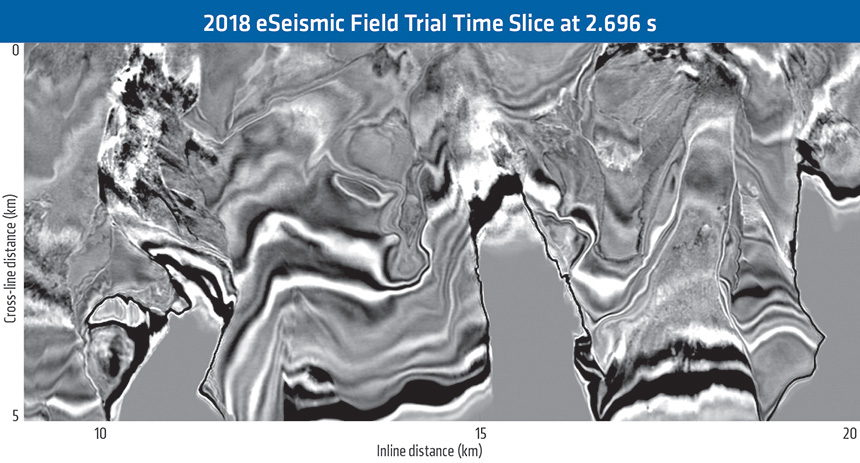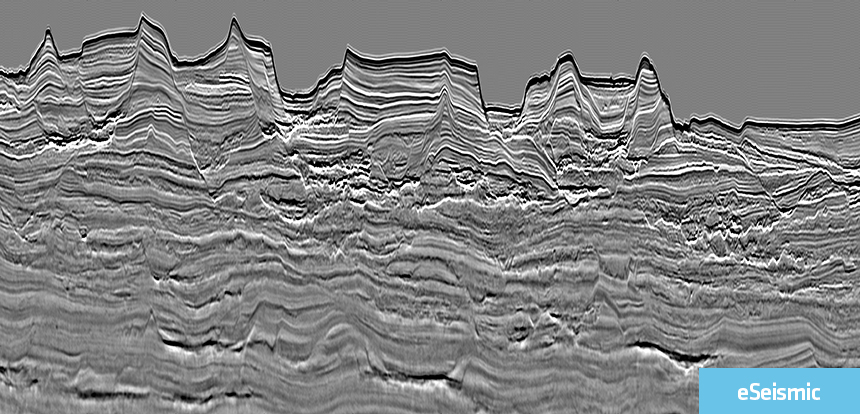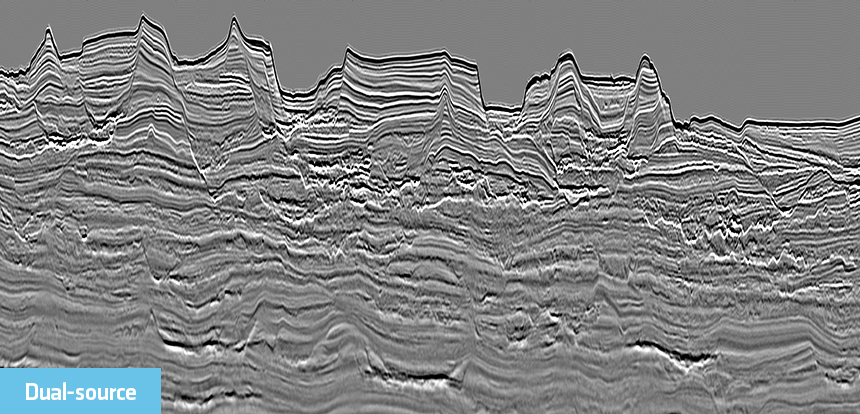This novel method is currently under development in PGS’ R&D unit and involves the continuous recording of seismic data for as long as it takes to acquire the sail lines. The sources are also operated continuously and the field trial confirms the potential benefits of recording of continuous source and receiver wavefields including reduced environmental impact, improved efficiency and better data quality. eSeismic development is funded by The Research Council of Norway, Equinor and PGS.

Time slice from the eSeismic 3D pilot survey in Brazil in 2018. Reducing the energy emitted reduces environmental impact whilst preserving data quality.
To use the method with existing equipment, individual air-guns are triggered in a near-continuous fashion with short randomized time intervals to generate a continuous wavefield. The emitted signals approach the properties of white noise making it possible to deconvolve the data with the total source wavefield.
The recent small-scale eSeismic trial survey was acquired with 16 x 8 100 m long multicomponent streamers with 100 m streamer separation. A constant streamer tow depth of 15 m was used. The source set-up consisted of six sub-arrays with air-guns and each sub-array was equipped with six air-guns. Individual air-guns were triggered with a mean interval between consecutive triggerings of several shots a second. The nominal separation between the sub-arrays of air-guns was 16.67 m. Since the source deconvolution using the proposed method can solve for one point source per sub-array of air-guns, so six point sources in the cross-line direction, the nominal cross-line bin size for this survey is 8.33 m. In the inline direction the receiver gathers have a trace spacing of 12.5 m. For comparison, a conventional dual-source acquisition with the same streamer geometry would deliver a cross-line bin size of 25 m.
Reducing Environmental Impact by Emitting Less Noise
One of the main potential benefits with the proposed method is reduced environmental impact of marine seismic sources. The peak sound pressure levels are significantly reduced by triggering one air-gun at a time compared to triggering many air-guns in an array simultaneously as in conventional marine seismic sources. Sound exposure levels are also reduced. The peak sound pressure levels are approximately 20 – 22 dB lower for the proposed method compared to conventional, whereas the sound exposure levels are 8 – 9 dB lower for eSeismic.
Better Data Quality by Increasing Sampling by 300%
Dense cross-line CMP spacing is achieved without compromising the acquisition efficiency. The 800 m wide sail-line is sampled with 96 common mid points compared to 32 with a standard dual-source configuration. The bin size of the 3D migrated volume is 12.5 x 12.5 m.
Improving Efficiency
From an efficiency standpoint, there are minimal vessel speed limitations since this method does not require the seismic recording or the sources to be triggered with specific spatial intervals. Limitations imposed by shot cycle time and record length are now relaxed.
Imaging Continuous Wavefields
On the receiver side, all the continuous data are processed at once to maintain the continuity of the data. After receiver motion correction of each measured component, the measured data are in stationary receiver positions and the deconvolution of the emitted source wavefield can be performed. This is done by computing the entire emitted source wavefield that can contribute to each stationary receiver location. In order to enable a stable deconvolution of the source wavefield, the source wavefield needs to be as white as possible without deep notches in the spectrum.
In addition to continuous seismic recording, near-field hydrophone data needs to be recorded continuously in order to be able to determine the wavefield emitted by the individual source elements.
Contact a PGS expert
If you have questions related to our business please send us an email.

